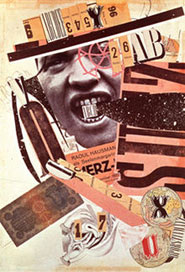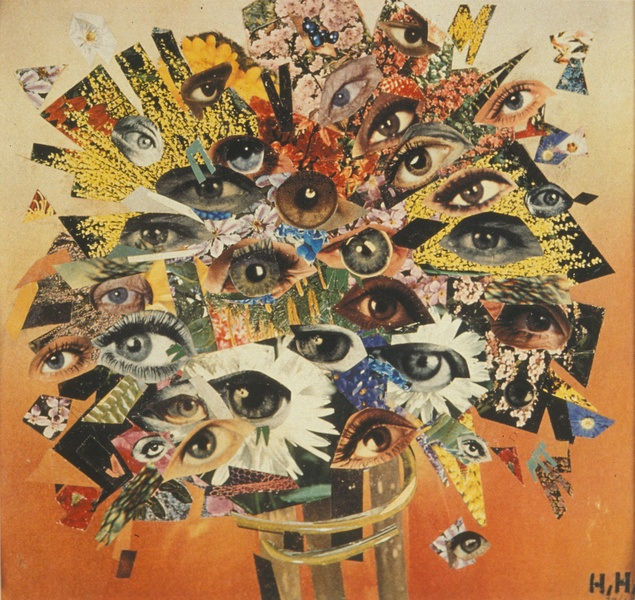The DaDa movement was an art movement which
came about during world war one and started in Zurich, Switzerland but then
spread all across Europe and the rest of the world to cities such as Paris,
berlin and even cities like New York. It
was movement which reacted and retaliated to the horrific nature of the war and
the things which had led to the war, things such as nationalism. It was a
movement which was influenced by many other art movements such as cubism,
futurism and expressionism but aside from art movement it was mainly influenced
and motivated by the environment the artists were living in and a reflection of
their reality. the movement came to public's notice around 1916 and ended around
1924, because it was a retaliation against the war it was very likely that it
would be at its most popular during this time but once the war had ended the
art movement hadn’t completely disappeared, it went on to become very
influential and powerful movement and influenced movements
such as surrealism and Avant garde. It also influenced many different artists
at the time. One of the reasons they influenced so many artist was because they
reached a lot of audiences due to the many different outlets such as photography, literature, sculptures, poetry, paintings
and most famously collages. One of the reasons it went on the influence surrealism and Avant garde
is because it was one of the first movements of art which didn’t focus on the
looks and the aesthetics of the art but rather focused on the message behind
it.
 (1)
(1) (2)
(2) (3)
(3)
 (1)
(1) (2)
(2)
Hannah Hoch
Hannah
Hoch was an artist born in Germany on November the 1st, 1889. Her first
experience with art was at the school of applied arts in Berlin, where she did
a course in glass design but was then interrupted by the first wold war; she
enrolled again at the school in 1915 and then studied painting and graphic
design. Just after this in 1918 she met Austrian artist Raoul Hausmann who then
introduced her DaDa circle in Berlin. She was the only woman in the Berlin DaDa
circle and was most well known for her photomontage works which involved
perceptions of gender and different ethnicity's.
Hannah Hoch - Cut with the Kitchen Knife through the beer-belly of the Wiemar republic (1919)
 (4)
(4)
Cut
with the Kitchen Knife was a piece of work created in 1919, it was a piece of
work which was a photomontage that reflected Hannah Hoch's political and social
views at the time of Germany's transition just after world war one. In this
piece of art you can see that one of the subjects she has focused on is the
subject of gender, for example you can see she has used words like
"kitchen knife" and "beer-belly", these are words which
were associated with typical gender stereotypes at this time. i think she has
also used the words "beer-belly" as a way to point out the German
army who were very highly focus on in the media at this time. I feel like she
has made the image so it has a very negative effect on the audience because of
the dullness and the lack of bright vibrant colours used in it, the only
colours which are used are browns, beige and the colour is blue which usually represents
things like sadness. In the image she has placed text in various parts, she has
used the name of the art movement 'DaDa' in it I think to make sure that
everyone is clear with what the image is trying to represent and that there is
more than the aesthetics of the image and a story behind it.
Hannah Hoch - Bouquet Of Eyes (1930)
 (5)
(5)
Bouquet Of Eyes was a piece of work created
by Hannah Hoch in 1930, it was a collage which included eyes being placed in
the shape and format of a bouquet of flowers. I think in this image there are a
lot of messages she is trying to get across, one of the reasons I think is that
there is a lot of focus on people and I think that she is emphasising that
people are looking at other people to be a certain way and conform with the
world and it would be noticed if anything you did was wrong of different. I
think she has softened this as well and tried to tell people other things because
of the colours used in the background, we can see a very calming orange at the
top of the image which transfers into a slightly darker orange at the bottom,
which I think makes the viewer look on into the image rather than just looking
at it. Another point I think she is trying to make is that everyone is equal, I
think she has done this with the eyes, some she has the eye and the surroundings
of it and some are just images of the eye-ball, I think she has done this to
represent that we are all equal because you can’t tell where there eye belongs
to someone of a specific gender, race, sexual orientation, religion or
nationality, but in this image I think she has focused in gender because of the
shape the eyes are in which is a bouquet and would be more associated with
women.
Raoul Hausmann
Raoul Hausmann was a artist who moved to Berlin at
a young age, his first experience with art came from his dad who taught
him how to paint, his first professional experience with art came from his work
with a magazine called "Der Sturm", up until 1917 he worked with many
different magazines in many different sections such as literature, in 1917 he
discovered Dadaist thinking in a magazine called "Cabaret Voltaire",
because he was very inspired by Dadaism and was a big fan of expressionism he
would then go on to be inspired to make the group called "Club DaDa"
along with fellow artists such as Hannah Hoch, Andre Breton and Francis
Picabia. During this club he along with the other artists involved
instead of concentrating on traditional types of art involving paint and oil
paints they would concentrate on things like photomontages poster poems and
collages which were a combination of a lot of types of art, because this was
done at this time many people were shocked which conformed with what they were
trying to get a cross in the art I think.
Raoul Hausmann - The Art Critic (1919)
 (6)
(6)
The Art Critic is a piece of work created by
Raoul Hausmann in 1919, it’s a collage which contains a poem poster that was
created but Raoul Hausmann. in this image we can see there is a cut out of two
people (one is the body and other the head) in the foreground which is made to
be the main focus, in the main focuses hand we can see a sharp object and i
think because it’s called "the art critic" I think the object is
there to emphasize the disapproval of certain pieces of
art. in the background we can see a money bill just behind the main focus on
his shoulder, I think this is there because it relates to when people say you
have an angle and a devil on your shoulder telling you what to do, in this
image I think it shows that money is his main focus and that’s all he’s
listening to. In the background we can see that there is writing, rather than
this meaning something I think it’s there to draw the viewer’s eye to the back
of the image so they can see all the different layers.
Raoul Hausmann - Tatlin at Home (1920)
 (7)
(7)
Like a lot of other DaDa pieces
Tatlin at Home by Raoul Hausmann is a photomontage, it was created by Raoul
Hausmann in 1920 while DaDa was very popular. in this piece of work we can see
a man in the image called Taltin, this is a message in the art aimed at and
against Vladimir Tatlin who was a painter and architect who was into the
constructive movement and believed that art had to have a reason and had to be
rationalized, whereas Raoul Hausmann was a big fan of using his art to send a
message and tell a story, because of this an artist like Tatlin was a perfect
main focus to use. in this image there are a lot of dark and negative colours
used such as dark reds, blacks and grey, I think Raoul Hausmann has used
these specific colours to excaudate how much he doesn’t think art needs a
reason behind it and can be used as a way to express and tell stories. In this
image we can see Tatlin who’s the main focus with a lot of machinery and non-natural
things in his head I think he has done this to stick with the theme that art
needs a reason and needs to be justified, I think he has done this to say that
its natural to show emotions and feeling in art and that reasoning and
rationalization comes from a mechanical mind that’s been built by things that
have been taught to us throughout our life.
bibliography
(1)-http://www.designhistory.org/Poster_pages/images_posters/Hausmann1924.jpg
(2)-http://www.dada-companion.com/hausmann/images/1920_200px_tatlin.jpg
(3)-http://www.artvalue.com/image.aspx?PHOTO_ID=1952813
(4)-https://upload.wikimedia.org/wikipedia/en/6/6b/Hoch-Cut_With_the_Kitchen_Knife.jpg
(5)-https://armtaste.files.wordpress.com/2013/09/elramo.jpg
(6)-http://www.dada-companion.com/hausmann/images/1919_200px_critic.jpg
(7)-https://utopiadystopiawwi.files.wordpress.com/2013/01/hausmann-tatlin-at-home-1920.jpg?w=195&h=300
No comments:
Post a Comment